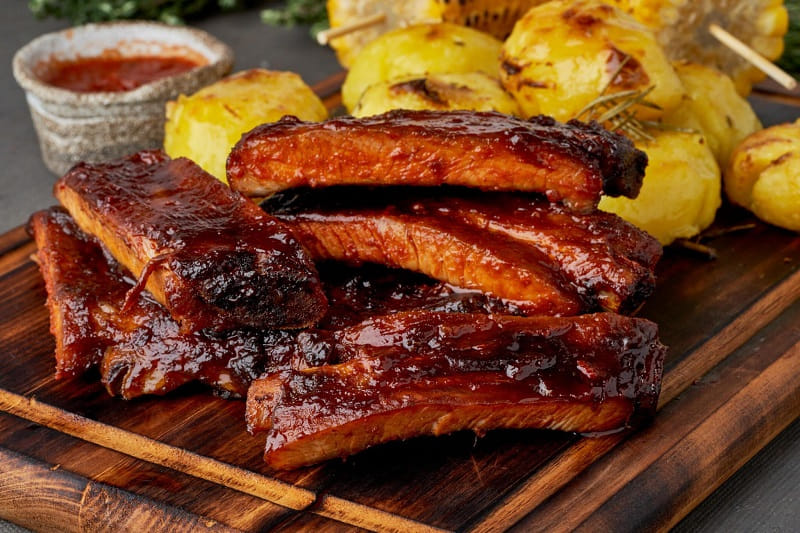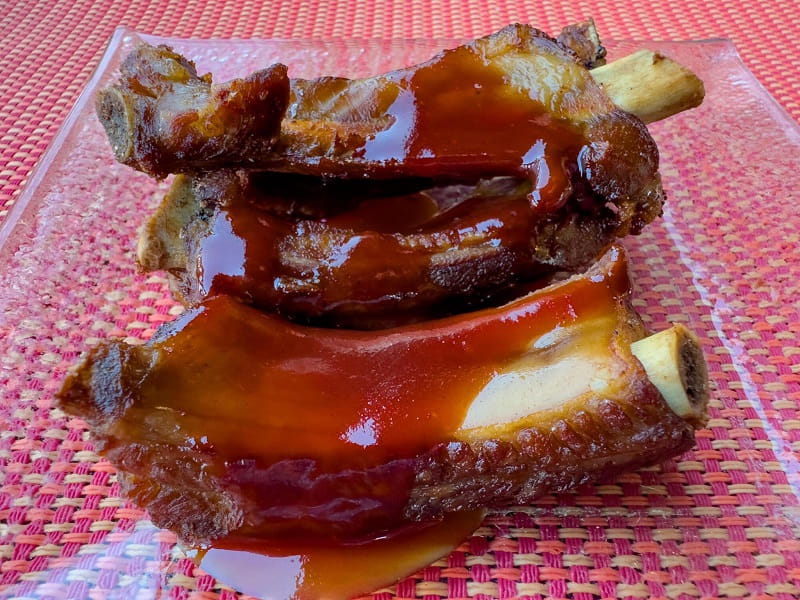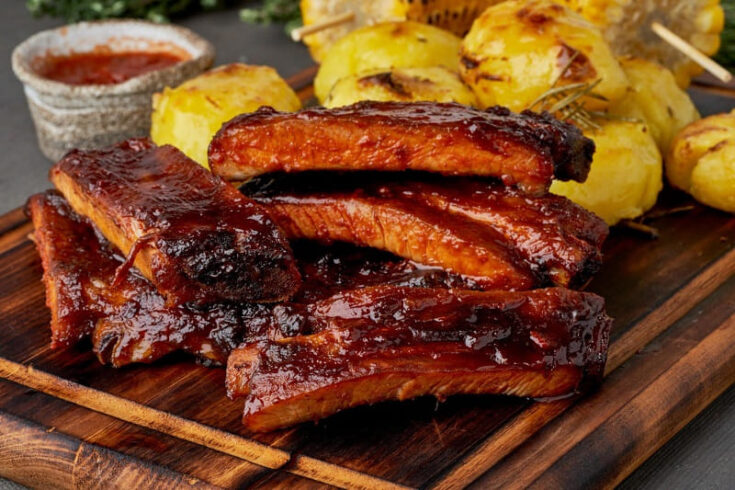If you’re craving tender and succulent ribs with a rich and smoky flavor, look no further than our mouthwatering Oven-Baked Spare Ribs Recipe. This recipe will guide you through creating melt-in-your-mouth ribs that are slow-cooked to perfection in the oven. Get ready to savor the aromatic blend of spices and the irresistible tenderness of these ribs as we take you on a culinary journey with our incredible oven-baked spare ribs.
Choosing The Right Type Of Ribs
When choosing the right type of ribs for your oven-baked masterpiece, there are a few options to consider. The most common types of ribs are baby back ribs and spare ribs.
- Baby back ribs come from the top of the rib cage, near the loin area, and are known for their tenderness and mild flavor. They are smaller in size and contain less meat compared to spare ribs. Baby back ribs are perfect if you prefer a leaner cut with delicate flavors.
- Spare ribs come from the bottom of the rib cage and have more meat on them. They have a slightly fattier content and offer a richer taste. Spare ribs require longer cooking time to break down the connective tissues and achieve that melt-in-your-mouth texture. Spare ribs might be your best bet if you’re looking for a more indulgent and flavorful experience.
Whichever type of ribs you choose, ensure they are fresh and high-quality. Look for racks with good marbling to ensure juicy and delicious results. You can also ask your butcher for recommendations based on your preferences.
The Importance Of Removing The Membrane

When it comes to oven-baking spare ribs, removing the membrane is one important step that should not be overlooked. This thin layer of tough connective tissue can be found on the underside of the rack of ribs and can hinder the cooking process if left intact.
By taking the time to remove this membrane, you will ensure that your ribs turn out tender and flavorful. The membrane not only acts as a barrier, preventing seasoning and marinades from penetrating the meat, but also prevents the ribs from properly absorbing smoke or heat during cooking. This can result in tougher, chewier ribs that are not as enjoyable to eat.
To remove the membrane, start by loosening one corner using a butter knife or your fingers. Once you grip it well, gently pull it away from the ribs smoothly. You may need a paper towel for better grip if it becomes slippery.
Removing the membrane creates more surface area for your seasonings and marinades to work their magic. This allows the flavors to penetrate deeper into the meat, resulting in more delicious and flavorful ribs. Additionally, removing the membrane helps render down any excess fat during cooking, giving you tender and succulent ribs with every bite.
Tips For Achieving Fall-Off-The-Bone Tenderness
- Slow and Low: This allows the collagen in the meat to break down slowly, resulting in tender and juicy ribs.
- Use a Dry Rub: Apply a dry rub to the ribs before cooking. This mixture of spices will add flavor and help tenderize the meat. Massage the rub into the meat and let it sit for at least 30 minutes before baking.
- Wrap in Foil: This steam bath method helps to tenderize the meat further and prevents it from drying out. After about an hour or so of cooking uncovered, wrap the ribs in foil and continue baking until they reach your desired level of tenderness.
- Baste with Sauce: During the final stages of cooking, baste the ribs with your favorite barbecue sauce. This adds flavor and helps caramelize the sauce onto the meat, creating a rich, sticky glaze.
- Rest Before Serving: Once cooked, allow the ribs to rest at room temperature for 10 minutes before serving. This allows the juices to redistribute throughout the meat, resulting in even more tender and flavorful ribs.
Read more:
- Standing Rib Roast Recipe
- How to Cook a Sweet Potato in the Oven
- How to Cook Pork Tenderloin in Oven
Tips For Adjusting Cooking Time And Temperature

- Consider the Size of Your Ribs: If you have thicker ribs, you may need to increase the cooking time or lower the temperature slightly to ensure they cook evenly and become fall-off-the-bone tender.
- Use a Meat Thermometer: To ensure that your ribs are cooked to perfection, it’s essential to use a meat thermometer. Insert the thermometer into the thickest part of the meat without touching the bone. The internal temperature should reach around 190°F for tender ribs.
- Adjust Cooking Time Based on Preference: If you prefer firmer ribs, decrease the cooking time by about 15-20 minutes from the recommended cooking time. On the other hand, if you like them extra tender, increase the cooking time by 15-20 minutes.
- Experiment with Different Temperatures: While most recipes recommend cooking ribs at around 275°F, you can experiment with higher or lower temperatures to achieve different results. Lower temperatures (around 250°F) will result in even more tender ribs but require longer cooking time. Higher temperatures (around 300°F) will yield slightly firmer but still deliciously tender ribs in less time.
- Adjust for Convection Ovens: If you’re using a convection oven, reduce the recommended temperature by about 25°F, as convection ovens tend to cook food faster and more evenly.
Serving Suggestions And Side Dish Ideas
Here are some serving suggestions and side dish ideas to elevate your rib feast:
- Classic BBQ Style: Serve your tender ribs with a generous dollop of homemade barbecue sauce. Pair them with traditional sides like coleslaw, cornbread, and baked beans for a complete Southern-style meal.
- Fresh and Tangy: Serve your ribs with a citrus-based sauce or marinade. Accompany them with a fresh green salad tossed in a tangy vinaigrette and some grilled vegetables for a light and flavorful meal.
- Asian Fusion: Add an Asian flair to your ribs by glazing them with a sweet, sticky teriyaki or hoisin sauce. Serve alongside steamed jasmine rice, stir-fried vegetables, and spring rolls for a delicious fusion feast.
- Comfort Food Extravaganza: Indulge in comfort food classics by pairing your ribs with creamy macaroni and cheese, buttery mashed potatoes, and roasted root vegetables.
- Mexican Fiesta: Turn your spare ribs into mouthwatering street-style tacos! Shred the tender meat and serve with warm tortillas, fresh salsa, guacamole, pickled onions, and cilantro-lime rice for a fiesta of flavors.
Oven-Baked Spare Ribs Recipe

Ingredients
- Spare ribs, baby back ribs, or St. Louis style ribs
- Your favorite barbecue sauce
Instructions
- Preheat your oven: Start by preheating your oven to 275 degrees Fahrenheit (135 degrees Celsius).
- Prepare the ribs: Place the ribs on a baking sheet, bone side down, and season them with salt and pepper to taste.
- Slow cook the ribs: Slide the baking sheet into the preheated oven and let the ribs cook for about 4 hours, or until the meat is tender and begins to pull away from the bones.
- Brush on the sauce: Once the ribs are cooked, remove them from the oven and increase the temperature to broil. Brush a nice, even layer of your favorite barbecue sauce onto the ribs. This will give them that irresistible sticky and flavorful coating.
- Broil for caramelization: Slide the baking sheet back into the oven, this time underneath the broil setting. Allow the ribs to broil for a few minutes until the sauce starts to bubble and caramelize. Keep a close eye on them to prevent burning.
- Serve and enjoy: Take the ribs out of the oven and let them rest for a few minutes before slicing. Serve them hot and savor the incredible juiciness and tenderness.

Hey readers! Chip Holland here, and I’m a Manager of this website. My passion for writing about it only matches my passion for BBQ. Follow my blog for mouth-watering recipes, tips, and tricks for the perfect smoke, grill, and BBQ. I’m sure you won’t be disappointed!
